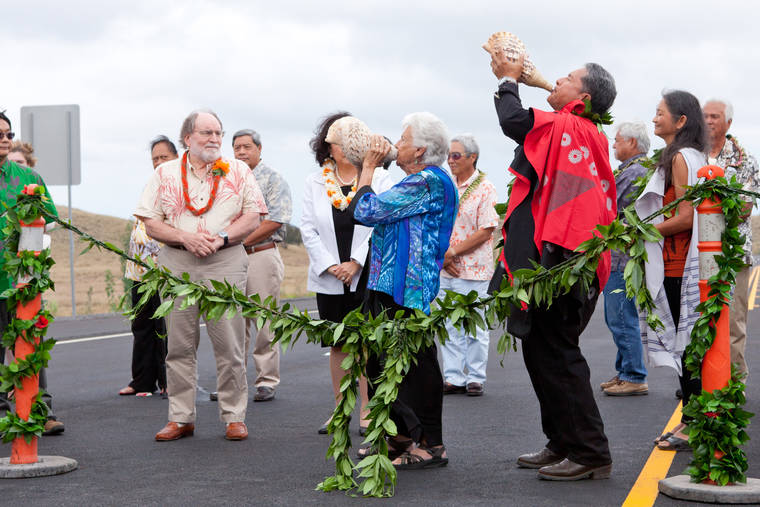 The late-Virginia Isbell, from the Saddle Road Task Force, blows a conch shell along with Daniel Akaka Jr. at the 2013 dedication and renaming ceremony of the new Daniel K. Inouye Highway.
The late-Virginia Isbell, from the Saddle Road Task Force, blows a conch shell along with Daniel Akaka Jr. at the 2013 dedication and renaming ceremony of the new Daniel K. Inouye Highway.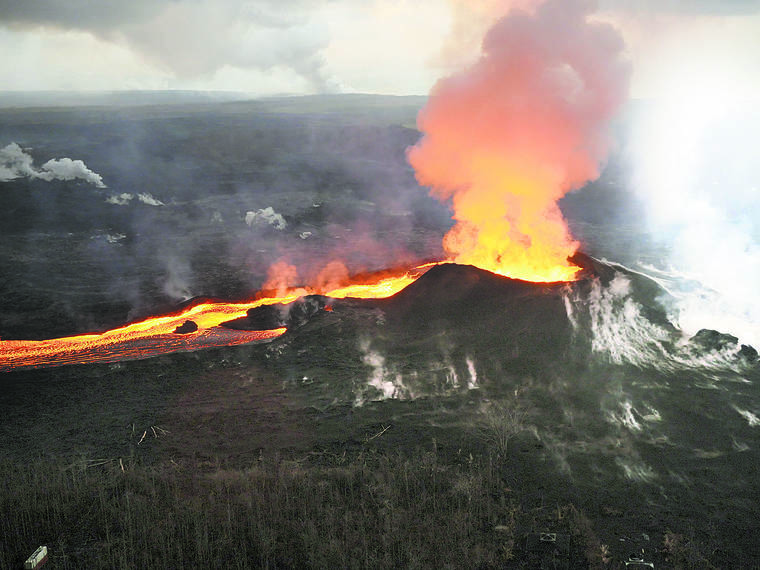 In this undated photo, fissure 8 is seen during a flyover of Hawaii Island during the 2018 eruption of Kilauea. USGS photo/Special to West Hawaii Today
In this undated photo, fissure 8 is seen during a flyover of Hawaii Island during the 2018 eruption of Kilauea. USGS photo/Special to West Hawaii Today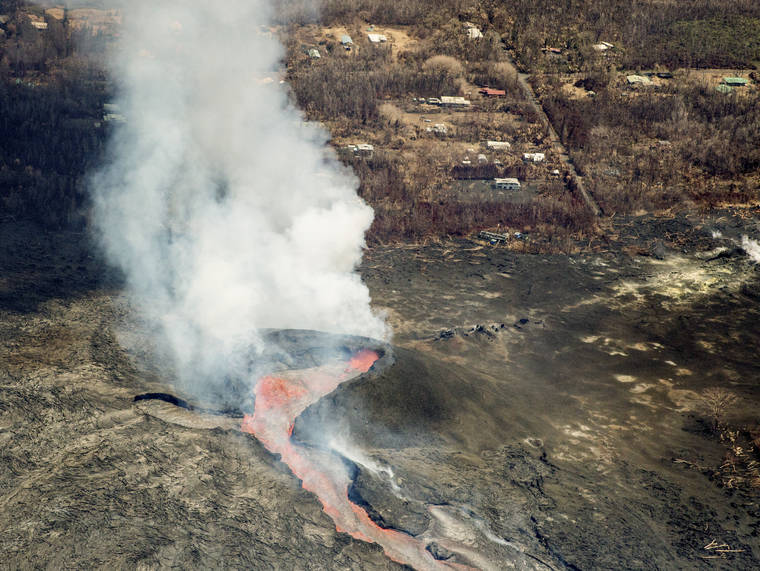 Fissure eight erupts in Leilani Estates on July 19, 2018. Hawaii Tribune-Herald file photo
Fissure eight erupts in Leilani Estates on July 19, 2018. Hawaii Tribune-Herald file photo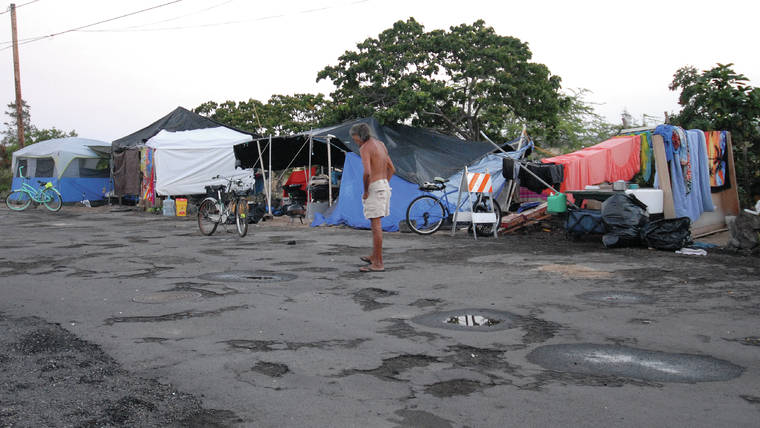 A resident of the homeless encampment at Old Airport Park wanders the area after being served with a notice to vacate in 2017. (Laura Ruminski/West Hawaii Today)
A resident of the homeless encampment at Old Airport Park wanders the area after being served with a notice to vacate in 2017. (Laura Ruminski/West Hawaii Today)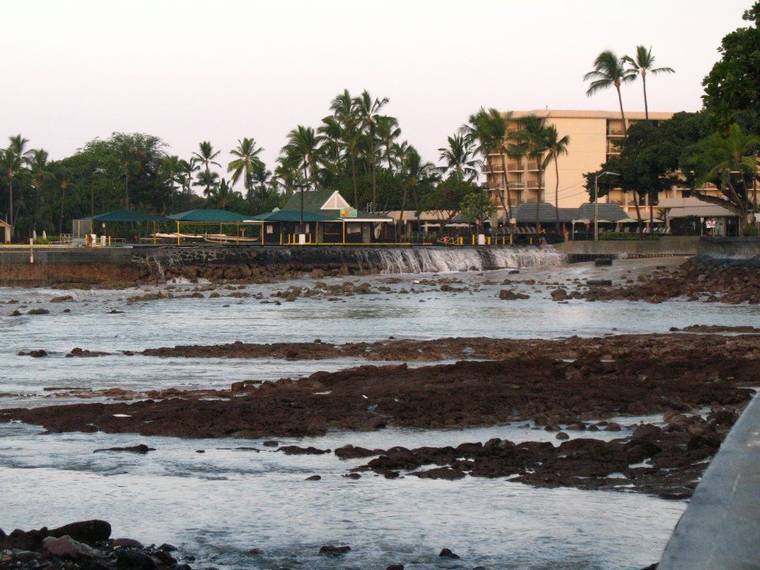 A tsunami pours over the seawall at Kailua Pier on March 11, 2011. (Chelsea Jensen/West Hawaii Today)
A tsunami pours over the seawall at Kailua Pier on March 11, 2011. (Chelsea Jensen/West Hawaii Today)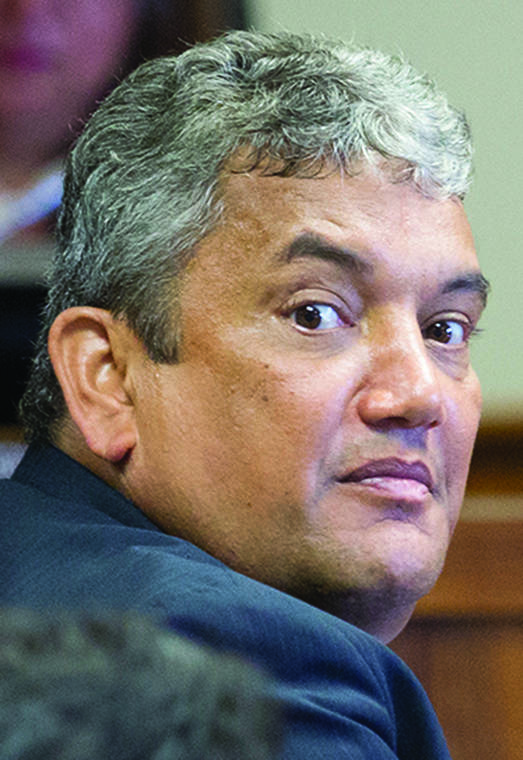 Billy Kenoi became the first sitting mayor to be tried on criminal charges in Hawaii history in 2016.
Billy Kenoi became the first sitting mayor to be tried on criminal charges in Hawaii history in 2016.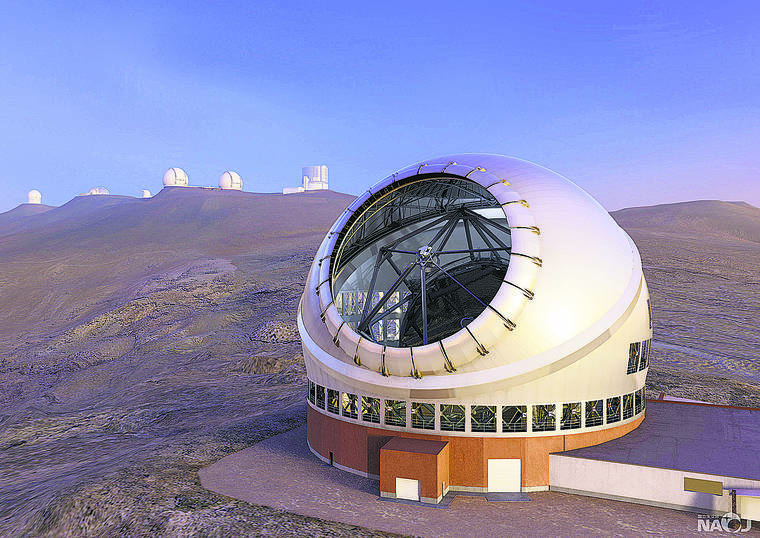 An artist’s rendering of TMT against a backdrop of other Maunakea telescopes.
An artist’s rendering of TMT against a backdrop of other Maunakea telescopes.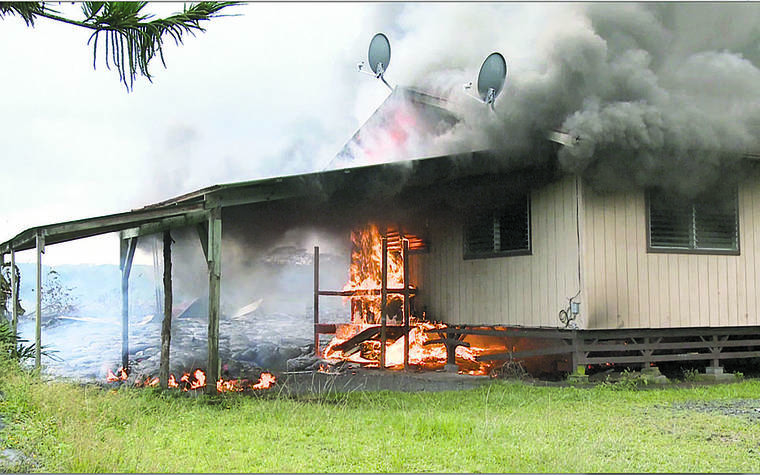 The first home to fall victim in Pahoa of the June 27th lava flow in 2014. (PHOTO COURTESY OF COUNTY OF HAWAII)
The first home to fall victim in Pahoa of the June 27th lava flow in 2014. (PHOTO COURTESY OF COUNTY OF HAWAII)
As we enter a new decade, here’s to West Hawaii Today’s top stories of the 2010s as voted over the year’s by the newspaper’s editorial staff:
2019
Impasse on Maunakea
On Dec. 26, for the first time since July, demonstrators opposing the construction of the Thirty Meter Telescope vacated the Maunakea Access Road, thanks to an agreement with Mayor Harry Kim that allowed for resumption of public access to the summit as of Dec. 28.
The story, see the 2019 top stories list for full recap, is yet to play out completely.
2018
Kilauea’s eruption
The wounds from the May 3, 2018, Kilauea eruption were still exposed and the fallout is still uncertain.
After fissure 8 retreated and lava no longer seared the Puna landscape, 700 homes had been destroyed and Kapoho Bay had been filled. Hawaii County plans to ask the state for $140 million in relief funds this legislative season, but the economic impacts are surely greater than that. Ag losses alone hit $30 million, while $5 million worth of taxable property melted from the county’s books. Roads and parks, meanwhile, still need rebuilding.
The eruption lasted until early September, but brought out the island’s best during that time, too. The grassroots nonprofit Pu’uhonua o Puna helped raised thousands of dollars and items in relief for displaced residents, as did countless other groups and individuals. The devastation turned out to be a platform that highlighted neighbors helping neighbors. But destruction was truly left in its wake.
2017
Homelessness on the forefront
Police ushered dozens of homeless out of tent cities at Old Kona Airport Park in August 2017 — a park that had long been the face of homeless living — declaring the area off limits for residential purposes. They followed the exodus with a park-wide cleanup effort.
But with nowhere to go, homeless began to push more heavily into Kailua Village and the Old Kona Industrial Area.
The county answered by developing Camp Kikaha, an open-air homeless camp alongside Hale Kikaha, 23 micro-housing units set up for the chronically homeless on a lot next to HOPE Services Hawaii’s Friendly Place.
The county ended the year in talks with the state to develop a 15-acre, permanent homeless living site mauka of Queen Kaahumanu Highway and south of Kealakehe Parkway. Those close to the project say that site work may begin by late summer 2018 if approved.
The effort received statewide attention.
2016
Kenoi Trial
Billy Kenoi became the first sitting mayor to be tried on criminal charges in Hawaii history. He was charged with theft and records tampering following West Hawaii Today’s 2015 reports that the popular and charismatic mayor used his county-issued purchasing card, known as a pCard, at hostess bars, other drinking establishments and for personal items such as a surfboard and bicycle.
After a high-profile, five-day trial that included testimony from two island journalists and a lot of accountant types, broken up by humorous quips from celebrity chef Sam Choy, a jury took about a day to clear Kenoi of felony theft charges. Kenoi, considered a rising star in the Democratic Party, acknowledged he reimbursed the county for more than $30,000 in personal charges. In all, he charged about $130,000 during his eight-year tenure, including numerous alcohol purchases.
Later, in a settlement with the county Board of Ethics, Kenoi admitted he violated the county ethics code in his use of his pCard and promised not to do it again.
2015
Thirty Meter Telescope
There will be no construction of one of the world’s largest telescopes atop Maunakea, at least as of the end of 2015. A ruling by the state Supreme Court on Dec. 2 declared that the Board of Land and Natural Resources shouldn’t have approved a permit to build the Thirty Meter Telescope before a contested case hearing was held. The ruling put the future of the proposed $1.4 billion next-generation telescope in limbo.
2014
June 27 Lava Flow impacts Puna
Kilauea’s now-named June 27 Lava Flow breakout started June 27, 2014, and continued in the new year threatening homes, roads and businesses in lower Puna costing county taxpayers more than $14.5 million, a figure that was expected to increase.
2013
Saddle Road is realigned, opens as Daniel K. Inouye Highway
The Saddle Road realignment opened to the public Sept. 7, 2013, what would have been the 89th birthday of the late Sen. Daniel K. Inouye, for whom the highway was named.
State and federal officials have been working since 2004 to improve the cross-island route. As of 2013’s end, some 41 miles of the 48-mile route had been improved, including the new alignment, which shaves approximately 18 minutes off the trip, bringing drivers to a terminus with Highway 190 several miles closer to Kona.
2012
Election problems
In a year when election news dominated local — and national — discussion, it was the problems on Hawaii Island leading up to the primary election and late-opening polls in West Hawaii that topped the year’s stories.
In early summer, County Clerk Jamae Kawauchi hinted at problems within the county’s voter rolls, going so far as to conduct an audit and meet with the state Attorney General’s Office. The investigation resulted in Kawauchi closing elections offices for a day, just weeks before the primary, which other elected county officials questioned. The closure, and Kawauchi’s comments, prompted a scathing letter from the state’s top elections official, who said he was fielding calls from worried island residents.
What did Kawauchi’s audit find? Fifty to 60 people voted twice in 2010.
Through all the buildup, elections employees were apparently stewing over Kawauchi’s decision to sack former Elections Chief Pat Nakamoto and several other employees in early 2012, after an investigation revealed possible improper conduct on county property. Several employees suffered a case of the “blue flu,” calling in sick on primary election day. The end result? Three polling places in West Hawaii opened late. State elections officials and Gov. Neil Abercrombie intervened, allowing several precincts to stay open later.
The state then took over the elections process for the General Election on the Big Island. That election wrapped up without incident on Hawaii Island.
2011
The March 11 tsunami
West Hawaii bore the brunt of the waves generated by the March 11, 2011, earthquake in Japan, with the worst damage in the state centered on Kona’s shoreline.
A house swept into Kealakekua Bay, household items littered the ocean floor, water damaged businesses along Alii Drive and tore up sections of the road itself. A deadly magnitude-8.9 earthquake in Japan generated the tsunami, giving Hawaii Island residents several hours advance notice before the waves hit local shores. Evacuation created gridlock, but no one on the Big Island was hurt.
Some island infrastructure, including Kailua Pier, sustained some damage, but by the end of the year, nearly every fix had been completed.
2010
Gubernatorial race
The election year kicked off early, with Democrat Neil Abercrombie making his first West Hawaii appearances in January. Abercrombie and his eventual Republican rival James “Duke” Aiona stumped here for months, taking questions and suggestions from Big Islanders, promising a more efficient and effective governance. In July, former Honolulu Mayor Mufi Hannemann formally threw his name into the race, running against Abercrombie in a primary that brought lots of gubernatorial attention to West Hawaii.
Voters will likely recall that primary campaign, and the subsequent General Election contest between Abercrombie and Aiona, as one full of mudslinging, name-calling and even a bit of race-baiting. In the end, neither Hannemann nor Aiona came close, as Abercrombie called on decades of political connections, as well as months of personal encounters with voters around the state, to soundly defeat both challengers.
Abercrombie took office in December, and quickly depleted the Big Island’s senatorial contingent, calling on two of the island’s three senators to head administrative departments.
Note: The top story from each year was voted for in that particular year.
